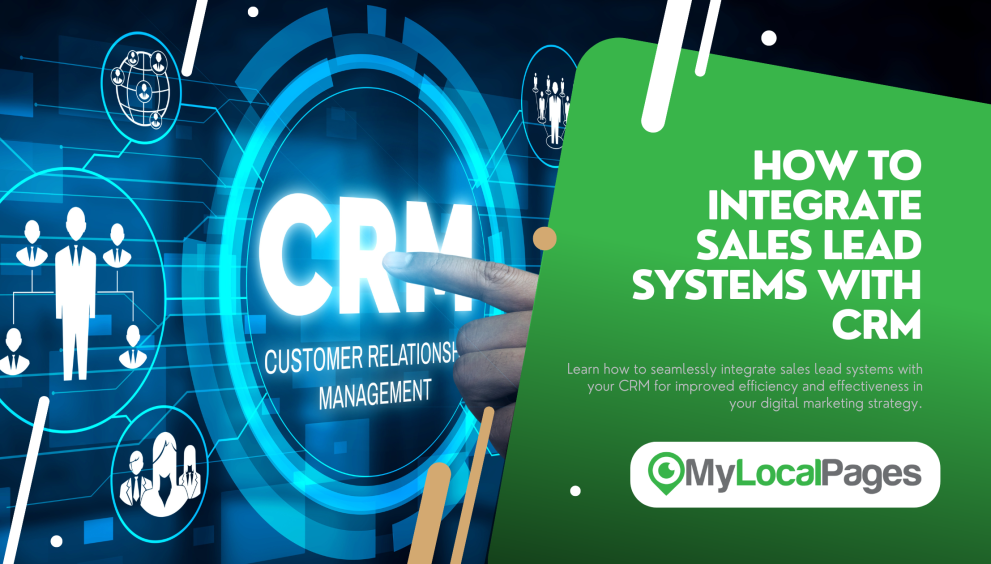How to Integrate Sales Lead Systems with CRM

In today’s competitive business environment, integrating sales lead systems with your Customer Relationship Management (CRM) platform is crucial for streamlining operations, enhancing productivity, and boosting sales performance. This guide will walk you through the process of integrating these systems, providing valuable insights and practical tips to ensure a seamless transition.
Need expert help with integrating your sales lead systems and CRM? Contact My Local Pages today for professional assistance.
Understanding the Basics: What is a Sales Lead System and CRM?
A sales lead system is a tool that helps businesses capture, track, and manage potential customers. It often includes features like lead scoring, automated follow-ups, and data analytics to help sales teams prioritize and convert leads efficiently.
A Customer Relationship Management (CRM) system, on the other hand, is designed to manage a company’s interactions with current and potential customers. It stores customer data, manages communications, and tracks customer interactions to improve relationships and drive sales growth.
For more insights on sales lead systems and CRM, read this comprehensive guide by Salesforce.
Benefits of Integrating Sales Lead Systems with CRM
1. Enhanced Data Accuracy
Integrating your sales lead system with CRM ensures that all your data is centralized and accurate. This eliminates the need for manual data entry, reducing errors and inconsistencies.
2. Improved Sales Efficiency
When your sales lead system and CRM are integrated, your sales team can access all the information they need in one place. This improves efficiency by saving time and enabling quick decision-making.
3. Better Customer Insights
An integrated system provides a holistic view of your customers. By combining data from both systems, you can gain deeper insights into customer behavior, preferences, and purchasing patterns.
4. Streamlined Workflows
Integration helps in automating workflows, such as lead assignment and follow-up tasks. This ensures that no lead is overlooked, and all potential customers are nurtured through the sales funnel.
Discover how integrating systems can transform your business by exploring this article by HubSpot.
Steps to Integrate Sales Lead Systems with CRM
Step 1: Assess Your Needs and Goals
Before integrating, it’s crucial to understand your business needs and goals. Determine what you want to achieve with the integration. Are you looking to improve lead tracking, enhance customer insights, or streamline workflows?
Step 2: Choose the Right Tools
Selecting the right sales lead system and CRM that can integrate seamlessly is essential. Popular CRMs like Salesforce, HubSpot, and Zoho offer robust integration capabilities with various lead management tools.
Need help choosing the right tools? Contact My Local Pages for expert advice tailored to your business needs.
Step 3: Plan the Integration Process
Create a detailed plan outlining the steps involved in the integration process. This includes mapping data fields, setting up integration workflows, and defining user roles and permissions.
Step 4: Data Migration and Synchronization
Ensure that all your existing data is accurately migrated to the new integrated system. Use data synchronization tools to keep your data up-to-date across both platforms.
Step 5: Test the Integration
Before going live, thoroughly test the integration to identify any issues or discrepancies. This helps in ensuring that the systems work seamlessly together without any hiccups.
Step 6: Train Your Team
Provide comprehensive training to your team on how to use the integrated system effectively. This ensures that they can leverage the full potential of the integration to drive sales and improve customer relationships.
Looking for professional training services? Contact My Local Pages to schedule a session with our experts.
Best Practices for a Successful Integration
1. Keep Your Data Clean
Regularly update and clean your data to avoid duplicates and inaccuracies. This ensures that your sales and marketing teams work with reliable information.
2. Monitor and Analyze Performance
Use analytics tools to monitor the performance of the integrated system. Track key metrics such as lead conversion rates, sales cycle length, and customer satisfaction to measure the effectiveness of the integration.
3. Continuously Improve
Integration is not a one-time process. Continuously seek feedback from your team and look for areas of improvement. Regularly update your systems and processes to adapt to changing business needs.
Stay ahead of the competition by reading this article on Forbes about driving business growth with CRM integration.
Integrating sales lead systems with your CRM is a strategic move that can significantly enhance your business operations and drive growth. By following the steps and best practices outlined in this guide, you can ensure a smooth and successful integration process.
Ready to take your business to the next level? Contact My Local Pages for expert guidance and support in integrating your sales lead systems with CRM.











